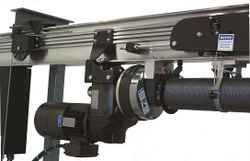
Posted to News on 25th Sep 2019, 12:25
Improve energy efficiency with supply and regeneration systems
Many drive applications could benefit from the use of supply and regeneration units, whereby kinetic energy from braking or recirculating can be reused and fed back into the DC circuit through the drive or fed back onto the mains power supply line, says Mark Checkley of KEB Automation.

Traditionally, if an application generated excess kinetic energy, it was simply dissipated electrically or mechanically - through a braking resistor or through friction. By utilising regeneration drive systems, this unused, "lost' energy now has valuable potential in many industrial applications by recirculating or feeding back onto the mains supply, reducing electrical running costs, as well as eliminating the heating effects from the braking resistors. The energy can also be put in "intermediate storage' and harvested for use later to cope with any peak energy demands (due to heavy loads or high accelerations) from the application. Generator load cycles also frequently occur with electric drives, where historically the energy was often "heated' in ballast circuits, can now take advantage of this technology.
Supply and regen units are able to supply and feedback the stored regenerated energy either from a single inverter or, where a common DC-linked system is used, several drive controllers, to the supplying network. Multiple drive configurations can be designed to match the required power through the cascading of multiple units. In supply mode, ensure the systems can pre-charge the DC-link to eliminate associated issues. The DC-link voltage corresponds to the rectified AC supply voltage.
When the energy is fed into the DC-link by one or several drives in a deceleration or braking operation, the Drive unit will feed this excess energy back to the mains power supply line, enabling access to this energy by other consumers on the grid. Depending on the system design, either standard chokes or harmonic filters can be used to improve the THDi (lower harmonics). With standard mains chokes, most industrial requirements can be fulfilled, including block-shaped regeneration. Using harmonic filters will result in an almost sinusoidal current waveform for supplying and regenerating energy (typical THDi
So applicable drives can either feed back into the DC circuits, reducing the total electricity used, or if not required, fed back onto the mains, provided the statutory regulations comply with G98, recouping energy costs or via intermediate storage which is now an option often looked at.
Typical applications
Regeneration becomes a compelling economic choice when the value of the recovered energy is large compared with the cost of a regenerative system. So if the system requires frequent braking and starting, or where there is speed control of overhauling loads, it would be worth considering, provided a clear understanding of the system dynamics are known. Some typical application examples include:
- Generators: connection of generators (e.g. combustion engines, wind energy plants and hydro-power plants) to a utility system, power quality standards can be met using harmonic filters.
- Centrifuges: regenerative braking of high centrifugal masses, utilisation of this kinetic energy is then achieved. Increased productivity can be gained due to short start-up and run-down times when multiple units are linked together.
- Theatre technology: by using drive regeneration units, no heating of resistors is required, energy is optimised, and low noise braking operation can be achieved.
- Cranes: where the hoist motor stops and reverses frequently and braking is required to slow the load during the lowering movement.
- Conveyor systems: in production environments, where conveyor belt drives or storage retrieval systems stop every few seconds or minutes. While stopped, the production parts are assembled correctly and then the belt starts moving again. DC-interconnected operation of multiple drives in these applications support energy sharing, peak energy can be returned into the mains line power supply, and no additional heat sources are required.
- Elevators: in passenger and freight elevators, braking and stopping are frequent. Traditional braking resistors can be replaced with a regeneration unit for the drives, which reduces fire hazards and achieves ROI typically in two years.
What are the benefits?
Supply and regeneration units are an easy replacement option for braking resistors and they can be used for all common supply voltages of 180...528V AC, 50/60Hz. Most are compact and lightweight, and are often supplied with an integrated pre-charging circuit along with optional choke or harmonic filter. As braking resistors are no longer required, supply and regeneration units can reduce the risk of heat / fire in sensitive areas, as well as reducing the cooling requirements of the environment. Optional fieldbus interfaces are normally provided as well as freely configurable inputs and outputs. For some applications, users can even fit energy meters in order to validate their energy savings.
For more information on Regen Units as well as the complete KEB portfolio, go to www.keb.co.uk.






























